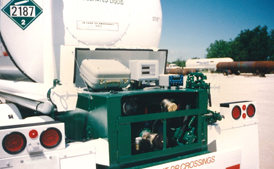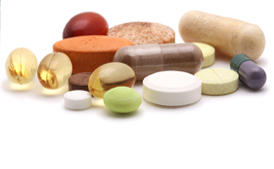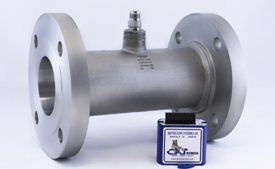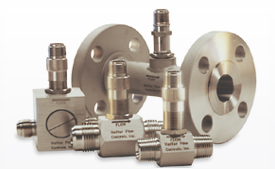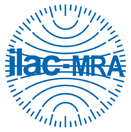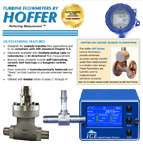Accurate Flow Measurement in Sanitary Applications
Flow measurement in the food and beverage and the pharmaceutical and biotech processing industries is one of the most fundamental and critical measurement applications affecting product quality, production efficiency, and regulatory compliance. Process engineers in these industries today have a wide array of technologies from which to choose when addressing these flow measurement applications.
Depending on parameters such as sanitary system design and certification requirements, fluid type (liquid, gas, steam, or cryogenic), material compatibility, Clean-in-Place (CIP) capability, fluid viscosity, flow range, and operating temperature and pressure to name some of the more prominent ones, an engineer can select from more than a half dozen flow measurement technologies. For decades, the sanitary-rated turbine flow meter has been one of the more popular technology choices today.
Still, like any other flow measurement technology, there are certain applications for which the turbine flow meter is best suited and provides the user with the best returns on their investment.
Turbine flow meters are velocity measurement devices.
A bladed rotor inside the flowmeter body/housing is engaged by a fluid passing through the body, causing the rotor to spin radially about a central axis or shaft parallel to the flow direction. The rotor blades are manufactured at an angle relative to the line of flow. In general, the steeper or greater the angle of the blade, the lower the flow range will be within certain hydrodynamic limits. A proximity sensor mounted in the wall of the flowmeter body is centered on the rotor so that the tips of the rotor blades pass through the annular space and body wall between the outside diameter of the rotor and the face of the proximity sensor. In modern sanitary turbine flow meters, the sensors are never wetted but rather sense the rotation through a portion of the flowmeter body’s wall.
Flowmeter K-Factor
The proximity sensor (magnetic or variable reluctance types are the most common) will, in turn, produce an electrical sinewave signal, the frequency of which is directly proportional to the rotational velocity of the rotor, with each blade tip passing by the sensor creating a peak in the signal. A calibration process can then determine how many peaks or pulses equal to a unit of volume (gallon, liter, cubic meter) have passed through the flow meter. This establishes the pulses per gallon (or pulses per liter, per cubic meter, etc.), also referred to as the flow meter K-factor. This principle of operation is common to all sanitary turbine meters.
In general, turbine flow meters are well-suited for clean, low to moderate viscosity liquids, most gases, and cryogenic fluids. Turbine flow meters, however, typically are not available in sanitary designs for gases or cryogenic fluids due to the need to use different types of bearings versus liquid service sanitary turbine flow meters. However, Turbine flow meters are often used with breathing gases and cryogenics forms of gases used in breathing service. Such meters go through specialized cleaning and packaging procedures by their manufacturer.
Turbine flow meters are not well-suited for use on steam flow measurement (though some can be exposed to steam for cleaning purposes for relatively short periods of time), high viscosity liquids, or highly abrasive liquids. The viscosity limits for a sanitary turbine flow meter are a function of size to a degree. Smaller size turbine flow meters typically have a lower maximum allowable viscosity capability compared to a larger size.
A rule of thumb for preliminary specification purposes is turbine flow meters can be used on viscosities as high as 50 centistokes for any size and up to 300 centistokes for sizes 2” and above. That said, small size turbine flow meters below 1” in size have been used successfully on viscosities as high as 200 centistokes. You should consult with your turbine flow meter supplier for their specific recommendations. However, most manufacturers of turbine flow meters will ask you for your fluid viscosity for every application as part of their sizing and quotation process.

Turbine flow meters offer specific advantages for the applications to which they are best suited, which include the following:
• Accuracy: A properly calibrated turbine flow meter can routinely achieve an accuracy (defined as linearity) between +/-0.1% to +/-0.5% of reading. High-accuracy turbine flow meters may also be combined with flow computers to correct for changing pressure and temperature that can affect fluid properties to achieve the desired accuracy for the application. The accuracy of a turbine meter in a clean, known fluid is unsurpassed by other flow meter techniques, making it the meter of choice for these applications that are frequently encountered in the food/beverage and pharma/biotech industries.
• Repeatability: Turbine flow meters exhibit repeatabilities (the nearness of two or more readings at the same flow rate) to within +/-0.05% of reading or better.
• Flow Range: On lower viscosity applications, turbine flow meters exhibit useable flow ranges equal to 20:1 to as high as 1000:1 as a maximum to minimum flow rate ratio. This is often referred to as a flow meter’s turndown ratio.
• Economics: From moderate initial acquisition costs to the low cost of ownership and long life expectancies, turbine flow meters provide exceptional value versus the level of measurement performance they provide.
Today’s turbine flow meters provide fast response, lightweight package, compact size, rugged construction, digital electronic cost advantage, and accuracy.
The Hoffer Advantage
The Hoffer Sanitary turbine flow meter product series shares all of the above characteristics plus many others more specific to sanitary flow measurement applications that are detailed as follows:
• Multiple finishes, including a mechanical polish of 30 micro-inch an electro-polish finish of 25 micro-inch and finer finishes available upon request to meet the most demanding requirements for sanitary applications.
• Field-proven in thousands of installations.
• Available in 11 sizes, ranging from 1/4” to 3”.
• Flow rates from 0.35 to 650 GPM available.
• Dual rated 316/316L stainless steel construction with sanitary tri-clamp style end fittings.
• Suitable for liquid sanitary applications, including Water for Injection (WFI), RO water, DI water, solvents, bottled water, beverages, and many others.
• CIP is capable of flushed cleaning with suitable cleaning liquids or steam.
Each Hoffer sanitary flow meter is designed and manufactured to comply with the ASME Bioprocessing Equipment Standard (BPE)-2016 for the highest possible sanitary assurance. ASME-BPE incorporates current best practices for enhancing product purity and safety and technology-specific recommendations to ensure proper operation. The standard results from widespread industry requests for guidance in designing and selecting sanitary system components and systems. It is the most stringent standard available today within the industry.
Cleaning Flowmeters
There are several specific processes to clean sanitary turbine flow meters, almost all of which involve liquid chemical cleaning and steam cleaning. It is important not to exceed the turbine flow meter’s temperature limits and maximum flow ratings with the latter. The turbine flow meter manufacturer should confirm material compatibility between the cleaning fluids and the flow meter. Elevated temperature cleaning using dilute acids should be reviewed with extra care to assure full compatibility. Hoffer Sanitary Series flow meters are fully cleaned when flushed and are available with a hard carbon composite sleeve bearing, suitable for steam cleaning.
Pharmaceutical Flowmeter Application Examples
Water for Injection
An excellent example of a well-suited pharmaceutical, sanitary turbine flow meter application is Water for Injection or WFI water. Eye drops, nose sprays, and a variety of hygiene products are based on ultra-pure deionized water. Also called water for injection (WFI), the liquid can be problematic for some other types of flow meters. Non-conductive, corrosive to select metals, and requiring sanitary-type flow meters, WFI was the source of challenges for one international healthcare product manufacturer.
Flow meters used in their WFI process were routinely replaced, causing downtime, cost, and potential contamination from a Rulon sleeve bearing that rapidly deteriorated. Following extensive testing, the customer determined that the Hoffer Sanitary Series turbine flow meter featuring 316/316L dual rated stainless-steel body and hanger construction, a 17-4 PH stainless steel rotor, and a carbon composite sleeve bearing was the most accurate and cost-effective solution for the application.

Pharmaceutical Pill Coating
There are numerous other applications within the pharmaceutical industry to apply turbine flow meters. This example actually uses a gas turbine flow meter to apply coatings to pills in a batching application. Pill coating adds to taste, enables proper pill digestion, provides time-release capabilities, and protects chemicals present in the tablet. Turbine flow meters are used to measure air for the pill coating process. The meter allows a predetermined amount of air to be released to control liquid coating within a specific reaction time. The solution in this application was a Hoffer HO Series turbine flow meter for gas to meter air.

Figure 3: Pharmaceutical flow applications span production and packaging, such as measuring airflow for the pill coating process.
Additional applications
In addition to increased use in the pharmaceutical/biotech industry, Hoffer’s sanitary flowmeters are also popular in food and beverage segments. Two examples of these applications include:
Midwest Brewery
A Midwestern brewery that produces 16 million 12-ounce beers daily selected the Hoffer sanitary turbine flow meter to monitor the filtered pure water flow. Hoffer was specified for its high accuracy and repeatability over a wide flow range, particularly critical since it is alarmed for low flow conditions. The customer can check for a leak in the system or a possible malfunction should an alarm occur. Multiple 1? Hoffer flow systems have been installed in this large brewery for this critical application.
Sanitary Flow meters for the Beverage Industry
Hoffer Flow Controls’ turbine flow meters play a key role in bag-in-a-box production plants throughout the beverage industry. One carbonated beverage production facility in the Pacific Northwest uses Hoffer meters to batch water and various syrup products, producing 12.5 million gallons per year. In addition to metering the beverage product, the turbine flow meters are exposed to regular clean-in-place CIP scenarios. The filling station may be cleaned with hot water, steam, or a suitable CIP fluid, including caustics and acid-based solutions up to six times per day.
Summary
Turbine flow meters excel in applications with high sanitary standards. The Hoffer Sanitary turbine flow meter is designed to provide outstanding accuracy in liquid applications for the pharmaceutical, food, and beverage industries. Hoffer is a leader in providing flow meters that adhere to the most stringent standards in the industry and those that solve customer-driven challenges. Superior accuracy, efficiency, quality, durability, and mechanical stability provide the pharmaceutical user a cost-effective and reliable solution for its flow meter requirements.
While Hoffer sanitary flow meters feature a mechanically simple core design for easy maintenance and field service, the company’s goal is to provide flow meters that address specific customer needs. Rather than take a “one size fits all” approach, Hoffer takes an application-driven systems approach with its flow meters, making the system work for each customer to the point of customization when appropriate.
Let’s talk about your flow meter needs. Reach out to us at info@hofferflow.com
You may also click to Request A Quote online.
About Hoffer Flow Controls
Hoffer Flow Controls has been designing and manufacturing quality liquid turbine flowmeters and related process instrumentation for more than fifty years. Our initial experience was in the field of cryogenic flow measurement. Today our reputation in this field is synonymous with quality. Today Hoffer Flow Controls manufactures high-precision turbine flowmeters to measure clean liquids and gases throughout the processing industries. Please be sure to follow Hoffer Flow Control on Linked In
 Company News
Company News




